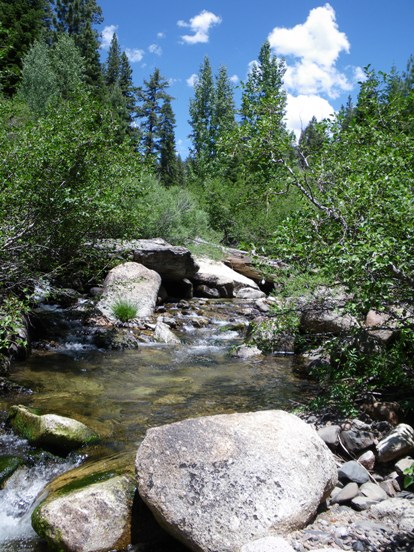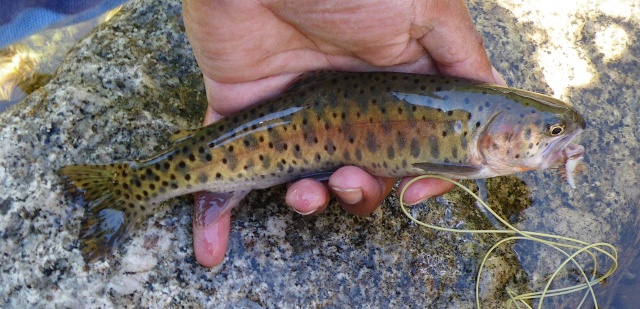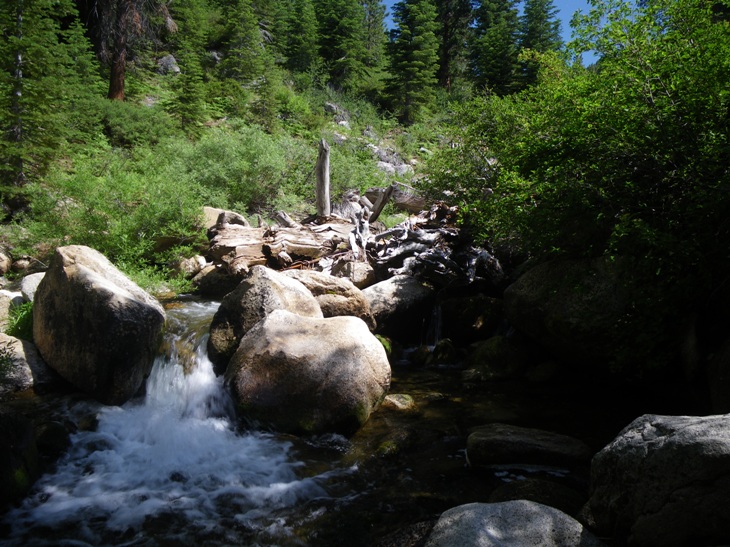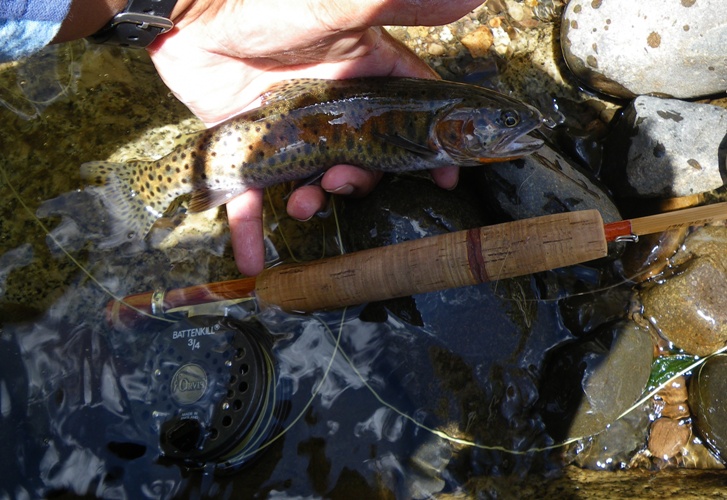|
|
|
|
|
July 23, 2009 Lahontan Headwater Stream Time: 10:30pm - 2:00pm Narrative: Modesto makes a good place from which to launch trips into the Sierra. With easy access to highways 88, 4, 120 and 108 the possibilities are endless. It’s a short two hours to just about any type of high country fishing one can imagine. So it was from Modesto that I launched this latest trip. Fresh off of 4 days in the Emigrant Wilderness, I hadn’t felt hypoxic in two days and felt a backcountry quick trip was in order. It was a tossup between a headwater Lahontan stream and fishing in Yosemite. The Lahontan stream won. This is one of a half dozen or so Lahontan streams I’ve identified in this area and by far the most well known outside of the Upper Truckee; yet I had trouble getting real concrete, verifiable information. I’d heard from one source long ago that it was in an extremely remote area of the watershed, another source told me that it was extremely brushy and a third source, a person that seemed to have actually fished the creek, said that it had Paiute Trout and not Lahontan. Except for this tid bid, his information would prove to be accurate. “The trail goes straight up” he said, and “there are fish in all the pockets on the way up and then the stream enters the willows.” He then held up his hands to give me an estimate of size… These fish might be bigger than I expected.
Still not sure of what I was getting myself into, I stopped by the ranger station on the drive up. One of these days I’ll learn; the guys at the ranger station were nice but never seem to have any fishing information. “I don’t think there are trout in that stream” “I’ll check it out anyway”, I said. Not one to argue, the ranger pulled out his handy cardboard mounted map. “The trail follows the stream its entire length. You’ll have to bushwhack to get in there though”. Boy was this an understatement. “If you’re open on my way back, I’ll give you a fishing report”, I offered up. Which I did but now am wondering if that was such a good idea….. The trailhead was at the end of a long road that followed a better known and frequently fished water. The confluence of these streams does not hold cutthroats and hence the throngs that ply this relatively small stream are unaware of the gems held in a much smaller stream a short distance away.
True to my source's word, the trail switched back straight up immediately. The stream stair-stepped down a steep canyon from a flat plateau some miles above the trailhead. I gave careful thought to the information that I had received so far, trying to piece together a picture of the stream in my mind, in order to find a suitable place to fish. The stream was in freefall down the canyon, some part of which must create a natural barrier to the planter rainbows in the streams below. The map wasn’t any help in trying to identify were that barrier might be. I might have to try several spots before finding the right fish. The stream was brushy, perhaps too brushy to fish where the terrain flattened out. My best bet was to find some place in the upper part of the canyon and hope that it was open enough to fish. I could hear the stream as I made my way up the trail but the brush was so thick I couldn’t see it. At points along the trail I could see from the slanting contour of the mountain that it was a steep drop into the heart of the canyon. The trail would move far enough away to mute the sound of the rushing water and then return. When I thought I might have hiked far enough, I picked a relatively open area beside the trail and bushwhacked my way to the stream. Generally, when bushwhacking I try to find an area of lodgepole or similar type of pine trees. The plants seem to grow less dense in the shade of the pine and the going is slightly easier. The stream was different than I imagined. Brush lined the stream of course but the course of the stream was formed by boulders that had apparently rolled into position from higher up on the mountain. Some where quite larger and it was a difficult stream to navigate. It required a lot of belly climbing, that is climbing over a rock while simultaneously climbing under a bush on your belly. There was a lot of fallen timber and the whole place seemed snaky and a bit unstable. Later in the day as the canyon walls became steeper and steeper, I’d become concerned about some of the larger boulders actually rolling as they took my weight. Each step was accompanied by an escape plan. That would come later. When I first reached the stream, I took a quick lay of the land and didn’t see any fish. I strung up my 3 weight and cast just the leader to a small pocket. It’s not the type of place one might normally fish to but in all the roiling water before me, I figured the clear spots would be the places to fish. The clear spots of course being those places where the current ran slowly enough for me to see the bottom or doubled back on itself to create a crystal ball out of the currents.
I released the small cutthroat and just happened to look down at my feet. I was standing directly over two larger Lahontans. I made a few more casts to a run to my right. Smack, smack, smack, in a very short time I had determined that at least one Lahontan was holding in each likely spot. The fish struck fast and I didn’t get any solid hook ups. The fish were fighters and wiggled their way of the hook. The simple fact was that some of the fish simply weren’t heavy enough to get a good hook set on without launching them into orbit. The fish were Lahontans, maybe slightly hybridized but good enough for government work. (I suspect their dark color was due more to their environment than the hybridization but I really don’t know Lahontan’s well enough to make that determination.) It was obvious this stream had good numbers of fish, now it was time to try for bigger fish. The pecking order was easy to figure out. The larger fish were in the very best lies and the higher I fished, the larger the fish became. Once again I was extremely pleased by the performance of my new 3wt cane rod. It was designed exactly for this type of fishing and didn’t let me down. The overhanging nature of the streamside vegetation made it necessary to throw, accurate, tight loops with just the 8ft leader or with 20 feet of flyline and I was able to do both with ease. I was constantly amazed and pleased by how well the rod could turn over the fly, casting just the leader. It was a day were hard casts didn’t seem that difficult and a good drift was instantly rewarded.
Besides the logistical difficulties of the stream, I did have one problem. My strike to hook up ratio was terrible. I’d been fishing my cripple caddis imitation which is generally pretty easy to set the hook with. I had been fishing a very good run and apparently put down every fish in the pool when I pulled the fly back to me and took a good look at it. I had the feeling that the gap wasn’t wide enough. The problem wasn’t really the fly but really that, with that fly, on this particular piece of water, on this day, I just wasn’t getting the hooking ratio I wanted. I changed to an Elk Hair Caddis. The EHC drew fewer strikes and strikes from small fish. I knew that there was a larger fish directly upstream in the pressure cushion of a submerged rock. The water flowed over a long, angled rock at the head of the pool. The main current split, half flowed to the left and I had hooked a few smaller fish in the tail out but the other half flowed to the right, along a longish, straight rock before flowing over the submerged rock. It was a perfect big fish lie and I had already missed the fish on the cripple before switching to the caddis. It wasn’t interested in the Elk Hair Caddis. I looked in my box and thought about putting on a small para Adams but I was concerned about not being able to see it in some of the faster water and instead put on a 16 Klinkhammer special. Because of the hooks the Klinkhammers are tied on, a size 16 is a big fly and I figured big meal, big fish. I made the cast with some sort of reach. (The currents were constantly catching any errant fly line so reach casting into slower currents or onto rocks was necessary.) The Klinkhammer drifted perfectly down the wall of the straight rock and then disappeared. I’m not sure how a fish sucks down that big a fly without making a disturbance but one minute it was there and the next it wasn’t. I was taken aback for a minute and set the hook. My first fish over six inches came to hand.
That same sucking scenario would play itself out several times over the next few hours, always with the larger fish. In mid afternoon I decided it was time to go. The stream was getting a bit more dodgy and me a bit more uncomfortable. Unfortunately, there was no easy way out. The best ways out seemed to be to my left but of course, that would put me on the wrong side of the stream. I finally reached a point where it seemed more difficult to continue upstream than to climb out. I found a sandy washout area near some trees and using my trekking pole and some firmly rooted brush was able to pull myself out of the canyon. I couldn’t see the trail from the stream nor could I see it once I was further up the canyon brush but it was literally steps away. I did a little reconnaissance for easier access points upstream and then headed back to the car. Back at the ranger station I gave my report. “Lahontan Cutts in the upper portion of the stream” I said. “You mean all the way in the meadow?” He hadn’t said anything about a meadow earlier……..”no, in the brush, in the canyon”….. “Oh, OK…Thanks for the report”, he said and continued talking with his co-worker.
Previous Carson - Iceberg Wilderness Chronicle Chronicle Index
|






